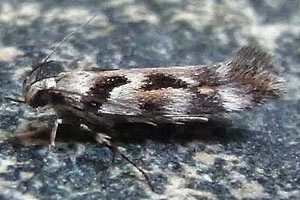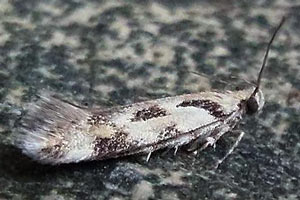

 +1Kontinente:EU
+1Kontinente:EU1. Lebendfotos
1.1. Falter
2. Biologie
2.1. Nahrung der Raupe
Strenggenommen noch unbekannt! Koster et al. (2020) haben aber einen sehr konkreten und gut begründeten Verdacht: "The specimens from Inagua on Gran Canaria were collected at light by Jari Junnilainen on the road side of GC-200. The light source was positioned near a spot where Asteriscus graveolens subsp. stenophyllus (Link) Greuter (Asteraceae) (Figs 15, 16) was dominant (previously known as Nauplius stenophyllus). The genus Asteriscus has a number of species occurring on the Canary Islands, partly endemic, partly also occurring on the African mainland (Goertzen et al. 2002). They occur on all islands where Alloclita canariensis was found (Hohenester and Welß 1993; Bramwell and Bramwell 2001). The fact that Asteriscus is related to Pulicaria and the abundant occurrence on the Gran Canaria locality make Asteriscus a likely candidate hostplant."
(Autor: Erwin Rennwald)
3. Weitere Informationen
3.1. Taxonomie
Die Barcode-Distanz zur nächstverwandten Art A. francoeuriae beträgt nach Koster & Junnilainen (2020: 103) 3,86 %.
3.2. Typenmaterial
Koster & al. (2020: 98) teilen mit: “Holotype. Spain – Canary Islands • ♂; Tenerife, Tamaimo; 28.27°N, 16.82°W; 550 m; 8–22 Nov. 2016; Per Falck leg.; genitalia slide: JCK 8685; DNA barcode sample COSM066–18; ZMUC; RMNH.INS.15578.” — Paratypen: 16 ♂♂ und 1 ♀.
3.3. Literatur
- Erstbeschreibung: Koster, S. J. C., Falck, P., Junnilainen, J., Karsholt, O. & E. J. van Nieukerken (2020): The francoeuriae species group in the genus Alloclita Staudinger, 1859 with description of A. canariensis Koster & Junnilainen, sp. nov. from the Canary Islands (Lepidoptera, Gelechioidea, Cosmopterigidae). — Nota Lepidopterologica 43: 95-116. [Digitalversion und Link zum PDF-Download auf nl.pensoft.net]




